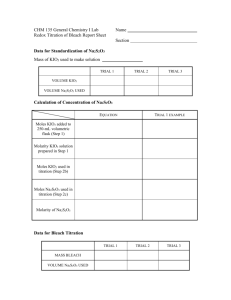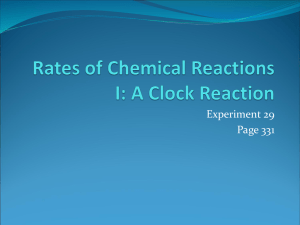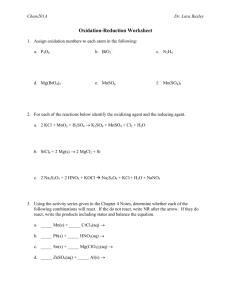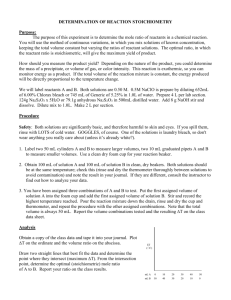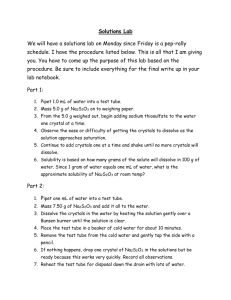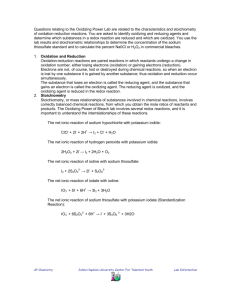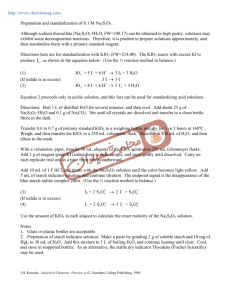Experiment 39
advertisement
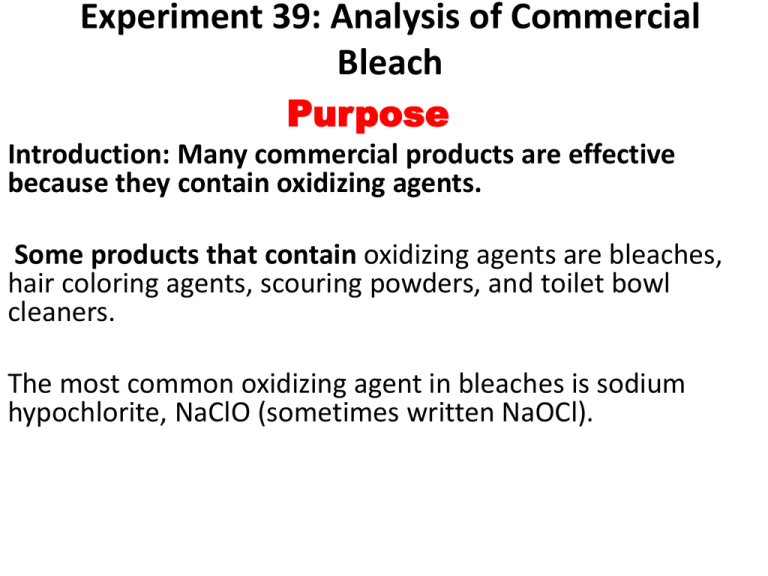
Experiment 39: Analysis of Commercial Bleach Purpose Introduction: Many commercial products are effective because they contain oxidizing agents. Some products that contain oxidizing agents are bleaches, hair coloring agents, scouring powders, and toilet bowl cleaners. The most common oxidizing agent in bleaches is sodium hypochlorite, NaClO (sometimes written NaOCl). The chemical equation for the process is: • Cl2(g) + 2(OH)- (aq) ---> ClO- (aq) + Cl- (aq) + H2O Terms Oxidizing agent – transfers oxygen atoms or gains electrons Oxidized – to give electrons Reduced- compound gains electrons • The amount of hypochlorite ion (ClO- ) present in a solution of bleach can be determined by oxidation-reduction titration. • One of the best methods is the iodinethiosulfate titration procedure. Iodide ion, I-, is easily oxidized by almost any oxidizing agent • (It has many electrons to lose!). In an acid solution, hypochlorite ions oxidize iodide ions to form iodine, I2. • The iodine that forms is then titrated with a standard solution of sodium thiosulfate. The analysis takes place in a series of steps: • 1.Acidified iodide ion is added to hypochlorite ion solution, and the iodide is oxidized to iodine. reduced 2H+ (aq) + HOCl(aq) + 2I-(aq) ---> Cl-(aq) + I2(aq) + H2O (l) Oxidizing agent oxidized • 3.The Iodine solution is titrated with a standard solution of thiosulfate ions, which reduces the iodine back to iodide ions: • I2+ (2S2O3) 2----> 2I-+ (S4O6 )2- Part A Dilute 1M Na2S2O3 to 0.05M Na2S2O3 • Pour 5 ml of 1M Na2S2O3 into a 250 ml beaker • Dilute with DI water until it reaches 100 ml • This will create a 0.05M Na2S2O3 Part A standardization of Na2S2O3 • Rinse and fill a burette with 0.05 M Na2S2O3 • Rinse and fill a second burette with .01 M KIO3 • Dispense 15 ml of KIO3 solution into a 250 ml Erlenmeyer flask – Add to flask 25 ml of water – 3ml of 3M KI – 2ml of 3M H2SO4 Part A begin titration • Slowly add Na2S2O3 • When the solution turns a light yellow add 0.5ml of starch indicator, the solution will turn black • Continue to add Na2S2O3 until the solution reaches an endpoint (turns colorless) • Calculate Molarity of Na2S2O3 using the formula below as seen on page 481 lO3-2 + 6S2O3-2 + 6H+ ---> l- + 3S4O6- 2+ 3H2O Calculations for standardization • Moles of lO3-2 = (.01 M lO3-2 x volume of lO3-2) • 6 x Moles of lO3-2 = moles of Na2S2O3 Part B Determination of the oxidizing agent of bleach • Fill burette with Your avg (M) Na2S2O3 • Add 0.5g of bleach into a 250ml flask • Record the mass of the unknown bleach Part B Determination of the oxidizing agent of bleach – To the flask add • • • • 25 ml of di water 3ml of 3M KI 2ml of 3 M H2SO4 5 drops of 3 % ammonium molybdate 2H+ (aq) + HOCl(aq) + 2I-(aq) ---> Cl-(aq) + I2(aq) + H2O (l) Part B begin titration • Slowly add Na2S2O3 to flask • When the solution turns a light yellow add 0.5ml of starch, the solution will turn black\ • Continue to add Na2S2O3 until it turns clear I2+ (2S2O3) 2----> 2I-+ (S4O6 )2- Part B begin titration • Calculate Moles of NaOCl using the formula below as seen on page 480 NaOCl + 2S2O3-2 + H+ ---> Cl- + S4O6 + H2O Calculations for titration • Moles of Na2S2O3 = (Part A)M Na2S2O3 x volume of Na2S2O3) • 1/2moles of Na2S2O3 = Moles of NaOCL Calculations for % oxidizing agent (OCL) • Mass NaOCl = Moles of NaOCl x (74.5g/mol NaOCl ) Mass of NaOCl X 100 Mass of unknown bleach = % oxidizing agent
